My Lovely Firebellied Toads
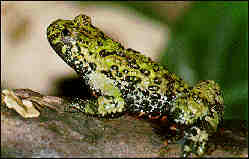

Two of my lovelies are
Oriental Firebellied Toads {
Bombina orientalis.}
They are named for their incredibly pretty bellies, which are neon orange with black spots.(belly view at right)
I never came up with names for these critters, but when I went to Europe a few summers ago, I left them with our pal Tim who works at our favorite bug-store...his 6 year old daughter came up with the names Flotsam and Jetsam. As it turns out, these are names of characters in Disney's The Little Mermaid movie.
These guys require a bit more work for upkeep in the home, but they are probably the best terrestrial frogs as pets for the beginner:
Food requirements: Crickets
This is a bit of a pain to deal with, but I actually got used to it pretty quick considering how much I hate bugs.
As it turns out, I live about a block from the pet store, so weekly trips for bugs isn't a problem. Often times, I'll just run down to the store on the weekend and grab about 2 bucks of bugs (that's about 24 small crickets). Then when I get home, I sprinkle them with calcium powder, and drop the whole mess of them into the frog tank. That will keep my 2 frogs (and 2 firebellied newts that share the tank) fed for the entire week... It's kinda gross on Mondays. Actually, it's REALLY gross on Mondays... that's when there's still a lot of bugs crawling around the tank...
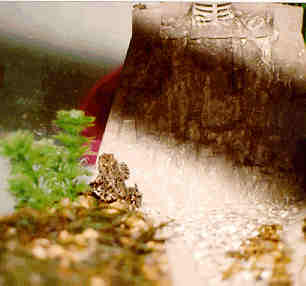 Generally though, there may be one or two casualties--dead floating crickets-- but most of the rest get gobbled up by the frogs and newts. Then before the next feeding time, I go scoop out the dead bugs.
Sometimes, like when I know I'm going to have company over for dinner, or if I'm leaving the frogs for a "frog-sitter" who won't be making so many trips to the bug-store, or when I just can't handle the idea of looking at lots of crickets in the frog tank or scooping out "floaters" (eeew!), I need an alternative.
That's when the spiffy bug container comes in handy.
You can buy a whole bunch of them and keep them in a little container for a week. (I hear you can house more for longer but that is just too many bugs for this squeemish pet owner to deal with at once.) You just stick a potato wedge in there, or you get this weird rock-like cricket food which is supposed to make them full of good-for-frogs calcium, and a wet sponge, and then you just dump some of the crickets in every other day, or every three days. I was amazed at how extraordinarily stupid crickets turned out to be. Check out my page on dealing with crickets for more info.
Pictured here on the right is one of the firebellied toads scoping out lunch (a cricket at the top of the waterfall.)
Generally though, there may be one or two casualties--dead floating crickets-- but most of the rest get gobbled up by the frogs and newts. Then before the next feeding time, I go scoop out the dead bugs.
Sometimes, like when I know I'm going to have company over for dinner, or if I'm leaving the frogs for a "frog-sitter" who won't be making so many trips to the bug-store, or when I just can't handle the idea of looking at lots of crickets in the frog tank or scooping out "floaters" (eeew!), I need an alternative.
That's when the spiffy bug container comes in handy.
You can buy a whole bunch of them and keep them in a little container for a week. (I hear you can house more for longer but that is just too many bugs for this squeemish pet owner to deal with at once.) You just stick a potato wedge in there, or you get this weird rock-like cricket food which is supposed to make them full of good-for-frogs calcium, and a wet sponge, and then you just dump some of the crickets in every other day, or every three days. I was amazed at how extraordinarily stupid crickets turned out to be. Check out my page on dealing with crickets for more info.
Pictured here on the right is one of the firebellied toads scoping out lunch (a cricket at the top of the waterfall.)
Habitat: Terrarium (land/water). No heater necessary (unless you live in an extremely cold climate.)
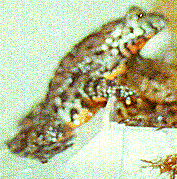 A ten gallon glass fishtank with 3/4 water, 1/4 land is ideal. The water needs to be about 2 to 4 inches deep. I used to have a couple of rocks and a plastic japanese tree that they liked to hang out on in my tank. This was very suitable and seemed acceptable, as long as they had some place to hide. I use this (10 gallon) tank when I leave them in at the frog-sitter's place when I go out of town for extended periods of time.
A ten gallon glass fishtank with 3/4 water, 1/4 land is ideal. The water needs to be about 2 to 4 inches deep. I used to have a couple of rocks and a plastic japanese tree that they liked to hang out on in my tank. This was very suitable and seemed acceptable, as long as they had some place to hide. I use this (10 gallon) tank when I leave them in at the frog-sitter's place when I go out of town for extended periods of time.
 About a year or so ago, however, I got kinda crazy and invested in an ultra-amazingly-cool 20 gallon tall tank, with a waterfall, river and pond. The kit is called Water's Edge Viquarium Kit (pictured at right). I've since seen these waterfall kits at various local pet stores, so they should be pretty widely available.
However, the setting does not need to be this extravagant.
!!!!! Warning: they are extremely sensitive to the water: the water must be stale and de-chlorinated or they will croak...literally! (meaning, leave the water out in a bucket for 24 hours before adding it to your frog tank!)
These guys also hop, so keep your tank covered!
For more information about setting up a tank, visit the Housing Your Pet Frog page.
About a year or so ago, however, I got kinda crazy and invested in an ultra-amazingly-cool 20 gallon tall tank, with a waterfall, river and pond. The kit is called Water's Edge Viquarium Kit (pictured at right). I've since seen these waterfall kits at various local pet stores, so they should be pretty widely available.
However, the setting does not need to be this extravagant.
!!!!! Warning: they are extremely sensitive to the water: the water must be stale and de-chlorinated or they will croak...literally! (meaning, leave the water out in a bucket for 24 hours before adding it to your frog tank!)
These guys also hop, so keep your tank covered!
For more information about setting up a tank, visit the Housing Your Pet Frog page.
Habits: VERY VERY active!!! These guys Hop, Swim, and
Sing all the time.
- They are extremely active and tend to run around all the time.
- They like to err...snuggle.. a lot when the weather gets warm but they seem to be extremely annoyed when their privacy is invaded.(Even though they make the silliest squeeky-toy noises that would make anyone look!) The male crawls up on top of the female, and much noisiness ensues. I haven't seen them lay eggs yet, though presumably this happens in the water.
- These guys are pretty into privacy, so it seems best to provide them with a good hiding place, whether it be a plant covering or hollow rock or log. Before I got mine a hollow rock (actually, its a statue of a giant SQUID!) to hang out in my frogs liked to squeeze down behind the waterfall in my tank...(which made the filter rattle and was really annoying.)
- When startled, these guys jump into the water and head for the bottom, where they hide for a while. If caught onland far enough from the water, they raise their heads really high to expose their bright colored bellies, as if to say: "I'm pretty, so I taste yucky!" Generally speaking, colored frogs are toxic, and will give any predator a stomache ache...if not worse.
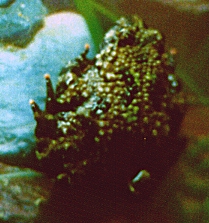
- The first time I saw one of these guys shedding its skin I was pretty startled! My toad sat down and started *bloating* himself up and looked like he was coughing! What he was actually doing was stretching himself to get the skin loose and then he started to rip it off with his mouth and gulp it down (ick! though I hear this has lots of good frog nutrients) till it was all off.... it took about a half hour or so, and was pretty gross while it was going on, but he was really clean and neat looking afterwards (all his colors seemed to be somehow brighter!)
They are slightly toxic, sometimes even to humans
- SO, wash your hands after handling. Of course, if you don't lick your fingers after touching them your probably pretty safe. Just cause a frog is toxic, it doesn't mean it will kill you! Some people do get nasty reactions, especially when they accidentally rub their face or eyes after handling the toads though, so you still should be careful about handling them.
- I have heard that some people get allergic reactions to the toxins, in the form of a light rash...but this is very very rare.
- They can however potentially damage other species! I got a letter from a visitor who told me that she put a Pac Man Frog twice the size of the firebellied toad in the same tank. Less than 5 minutes later the Pac Man Frog was dead...the toxins in the firebellied toad's skin had killed it!
Don't try licking these frogs-they're not that kind of frog!!!(sheeesh!)
For more information about Firebellied Toads check out:
My Lovely African Dwarf Frogs
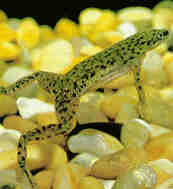
I have several
African dwarf frogs {
Hymenochirus boettgeri}.
These make
great pets for the beginner. They are as complicated to deal with as goldfish! Granted, you can't feed them fishflakes (they only eat food that sinks to the bottom of the tank!), but you don't have to feed them
live icky bugs either!
The picture on the left is a shot of a dwarf frog that I found floating around on Usenet groups...I've since seen it in several pet care books.
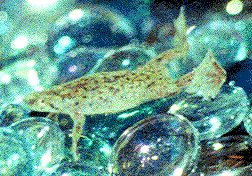
The shot on the right is a shot of Elwood II.
My first dwarf frogs were named Jake and Elwood, after the Blues Brothers. (It's a long story...lets just say I had been watching that movie a lot that summer) I had them for about 5 years. Unfortunately they passed away in a pH disaster in their aquarium several years ago.
I mourned for a week or so, then returned to the pet store to get new frogs.
I guess I wasn't feeling very creative when I named the 2 new guys, hence Jake and Elwood the second appeared on the scene. In addition, more dwarf frogs have been added to the family.
(Don't confuse these with
African Clawed Frogs or Albino Clawed Frogs, which are bigger and may actually
eat these guys!)
How to tell the Clawed Frog from the Dwarf Frog.

 Two of my lovelies are Oriental Firebellied Toads {Bombina orientalis.}
Two of my lovelies are Oriental Firebellied Toads {Bombina orientalis.} Generally though, there may be one or two casualties--dead floating crickets-- but most of the rest get gobbled up by the frogs and newts. Then before the next feeding time, I go scoop out the dead bugs.
Sometimes, like when I know I'm going to have company over for dinner, or if I'm leaving the frogs for a "frog-sitter" who won't be making so many trips to the bug-store, or when I just can't handle the idea of looking at lots of crickets in the frog tank or scooping out "floaters" (eeew!), I need an alternative.
That's when the spiffy bug container comes in handy.
You can buy a whole bunch of them and keep them in a little container for a week. (I hear you can house more for longer but that is just too many bugs for this squeemish pet owner to deal with at once.) You just stick a potato wedge in there, or you get this weird rock-like cricket food which is supposed to make them full of good-for-frogs calcium, and a wet sponge, and then you just dump some of the crickets in every other day, or every three days. I was amazed at how extraordinarily stupid crickets turned out to be. Check out my page on
Generally though, there may be one or two casualties--dead floating crickets-- but most of the rest get gobbled up by the frogs and newts. Then before the next feeding time, I go scoop out the dead bugs.
Sometimes, like when I know I'm going to have company over for dinner, or if I'm leaving the frogs for a "frog-sitter" who won't be making so many trips to the bug-store, or when I just can't handle the idea of looking at lots of crickets in the frog tank or scooping out "floaters" (eeew!), I need an alternative.
That's when the spiffy bug container comes in handy.
You can buy a whole bunch of them and keep them in a little container for a week. (I hear you can house more for longer but that is just too many bugs for this squeemish pet owner to deal with at once.) You just stick a potato wedge in there, or you get this weird rock-like cricket food which is supposed to make them full of good-for-frogs calcium, and a wet sponge, and then you just dump some of the crickets in every other day, or every three days. I was amazed at how extraordinarily stupid crickets turned out to be. Check out my page on  A ten gallon glass fishtank with 3/4 water, 1/4 land is ideal. The water needs to be about 2 to 4 inches deep. I used to have a couple of rocks and a plastic japanese tree that they liked to hang out on in my tank. This was very suitable and seemed acceptable, as long as they had some place to hide. I use this (10 gallon) tank when I leave them in at the frog-sitter's place when I go out of town for extended periods of time.
A ten gallon glass fishtank with 3/4 water, 1/4 land is ideal. The water needs to be about 2 to 4 inches deep. I used to have a couple of rocks and a plastic japanese tree that they liked to hang out on in my tank. This was very suitable and seemed acceptable, as long as they had some place to hide. I use this (10 gallon) tank when I leave them in at the frog-sitter's place when I go out of town for extended periods of time.
 About a year or so ago, however, I got kinda crazy and invested in an ultra-amazingly-cool 20 gallon tall tank, with a waterfall, river and pond. The kit is called Water's Edge Viquarium Kit (pictured at right). I've since seen these waterfall kits at various local pet stores, so they should be pretty widely available.
However, the setting does not need to be this extravagant.
!!!!! Warning: they are extremely sensitive to the water: the water must be stale and de-chlorinated or they will croak...literally! (meaning, leave the water out in a bucket for 24 hours before adding it to your frog tank!)
These guys also hop, so keep your tank covered!
For more information about setting up a tank, visit the
About a year or so ago, however, I got kinda crazy and invested in an ultra-amazingly-cool 20 gallon tall tank, with a waterfall, river and pond. The kit is called Water's Edge Viquarium Kit (pictured at right). I've since seen these waterfall kits at various local pet stores, so they should be pretty widely available.
However, the setting does not need to be this extravagant.
!!!!! Warning: they are extremely sensitive to the water: the water must be stale and de-chlorinated or they will croak...literally! (meaning, leave the water out in a bucket for 24 hours before adding it to your frog tank!)
These guys also hop, so keep your tank covered!
For more information about setting up a tank, visit the 
 I have several African dwarf frogs {Hymenochirus boettgeri}.
I have several African dwarf frogs {Hymenochirus boettgeri}. The shot on the right is a shot of Elwood II.
The shot on the right is a shot of Elwood II. 
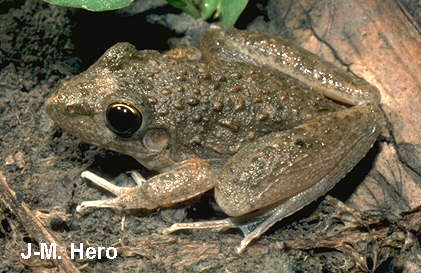

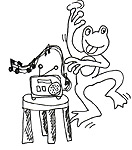

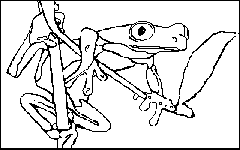

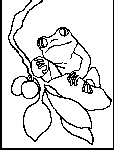


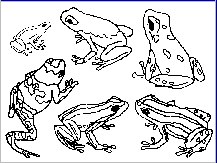
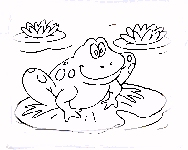



![[image]](http://allaboutfrogs.org/weird/pictures/burrowsm.gif) The Catholic frog (Notaden bennetti) is a yellow or greenish Australian myobatrachid which gets to be about 4 cm (1.5 inches) long. It was named for the dark, crosslike pattern on its back, and it lives in dry regions. The way it copes with drought is to live underground, emerging from its burrow after a heavy rain.
The Catholic frog (Notaden bennetti) is a yellow or greenish Australian myobatrachid which gets to be about 4 cm (1.5 inches) long. It was named for the dark, crosslike pattern on its back, and it lives in dry regions. The way it copes with drought is to live underground, emerging from its burrow after a heavy rain.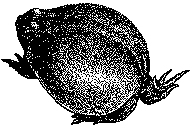 Another desert dweller is the Flat-headed frog (Chiroleptes platycephalus) which is also an Australian myobatrachid. It, too, lives in burrows and is noted for its' ability to store enough water in its body to take on a ball-like shape. *bloat*
Another desert dweller is the Flat-headed frog (Chiroleptes platycephalus) which is also an Australian myobatrachid. It, too, lives in burrows and is noted for its' ability to store enough water in its body to take on a ball-like shape. *bloat*
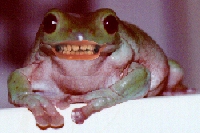

![[tadpole]](http://allaboutfrogs.org/weird/pictures/tad2.gif)
![[froglet]](http://allaboutfrogs.org/weird/pictures/frglet.gif)

![[toads mating]](http://allaboutfrogs.org/weird/pictures/mate1.jpg)
